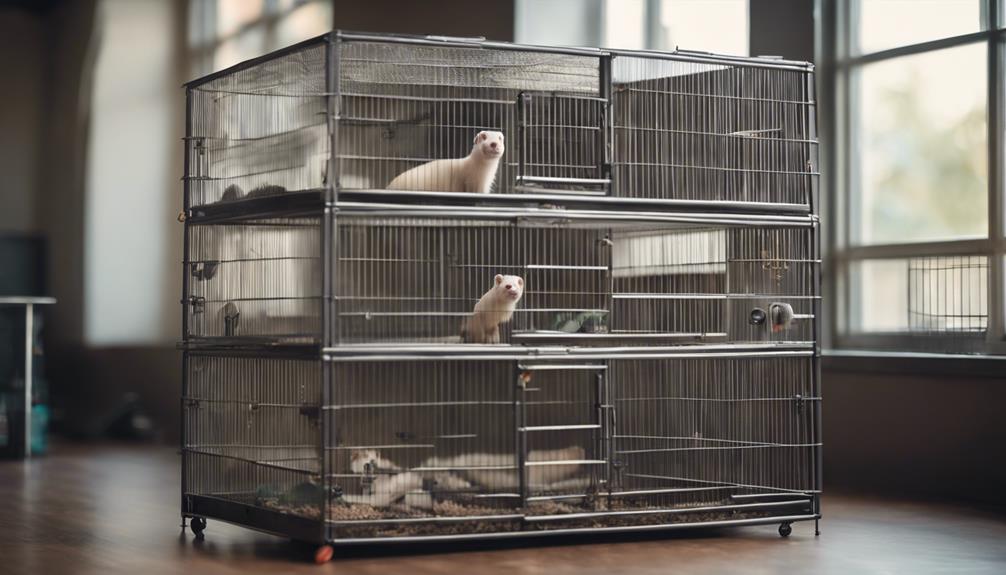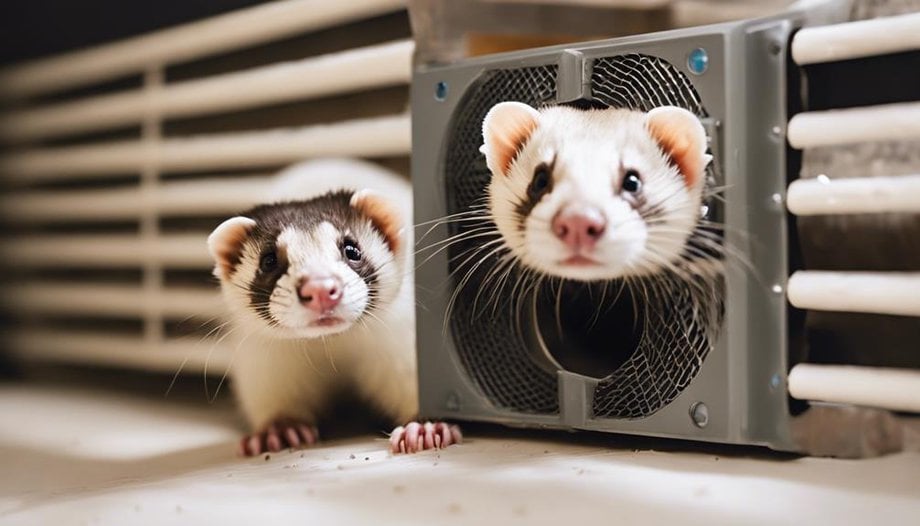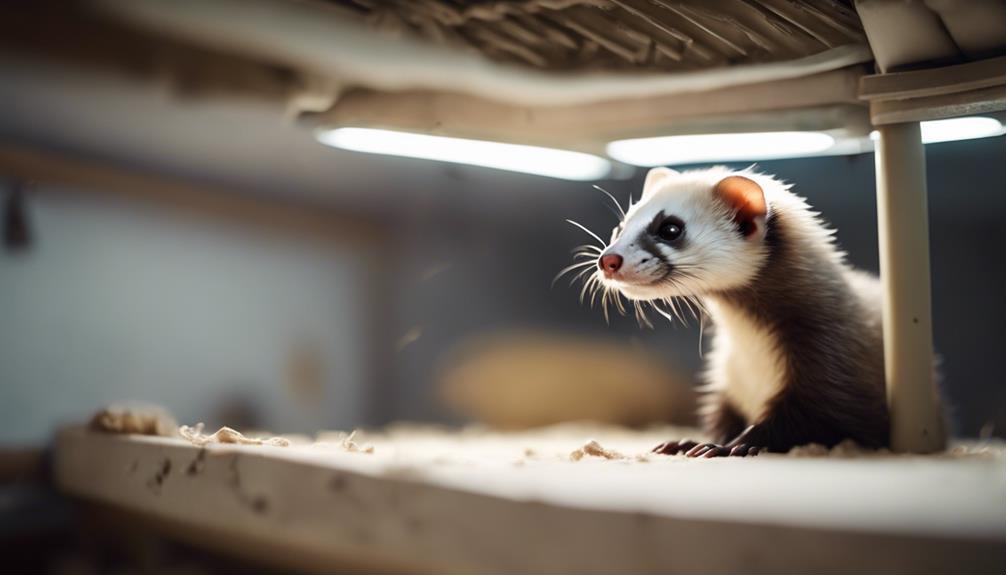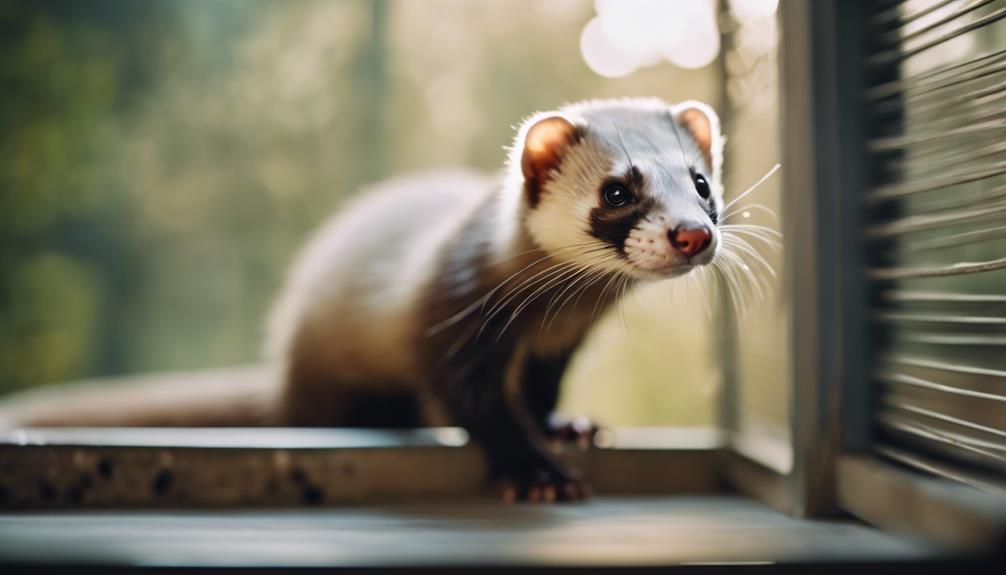How to Ensure Proper Ventilation in Ferret Habitats

Proper ventilation is crucial for maintaining a healthy environment for ferrets. Here are some essential tips to ensure proper ventilation in ferret habitats:
- Choose a well-ventilated cage or enclosure with adequate airflow to prevent the buildup of ammonia and other harmful gases.
- Place the cage in a well-ventilated area away from drafts and direct sunlight to maintain a consistent temperature and airflow.
- Clean the cage regularly to remove waste and debris that can block ventilation openings and reduce airflow.
- Use appropriate bedding material that allows for proper airflow and absorbs moisture to prevent mold and mildew growth.
- Avoid overcrowding the cage with too many ferrets or accessories, as this can restrict airflow and lead to poor ventilation.
- Consider using a fan or air purifier to improve air circulation and filtration in the ferret habitat, especially in areas with limited ventilation.
- Monitor the humidity levels in the ferret habitat and use a dehumidifier if necessary to prevent moisture buildup and improve ventilation.
By following these tips, you can ensure proper ventilation in your ferret's habitat, creating a fresh and safe environment for your furry friends.
Importance of Proper Ventilation
Proper ventilation is crucial for maintaining a healthy and comfortable environment for ferrets. Ventilation benefits ferrets by ensuring the air inside their habitat remains fresh and clean. Stagnant air can lead to a buildup of ammonia from urine and feces, which can be harmful to the respiratory system of these small animals.
To promote proper air circulation, there are various techniques that ferret owners can implement. One effective method is to place the ferret cage in a location with good airflow, away from damp or musty areas. Additionally, using a small fan on low settings can help circulate the air without creating a draft directly on the ferrets. Regularly opening windows or using an air purifier can also aid in maintaining good air quality within the ferret habitat.
Choosing the Right Cage

When selecting a cage for a ferret, consider factors such as size, material, and design to ensure a suitable living environment for your pet. The right cage plays a crucial role in providing a comfortable and safe space for your ferret to thrive. Here are some important considerations:
- Cage material considerations: Opt for cages made of durable materials like powder-coated wire or sturdy plastic to ensure longevity and easy cleaning.
- Space requirements: Ferrets are active animals that require ample space to move around, play, and explore. Choose a cage that provides enough room for them to stretch and engage in their natural behaviors.
- Ventilation effectiveness and temperature control: Look for cages with good ventilation to maintain fresh air circulation and prevent the buildup of odors. Additionally, consider the cage's ability to regulate temperature to ensure your ferret stays comfortable in various weather conditions.
Selecting a cage that meets these criteria will contribute to creating a healthy and enjoyable habitat for your ferret.
Placement of the Habitat

Position the ferret habitat in a well-lit area with minimal drafts to ensure your pet's comfort and well-being. Choose a location away from direct sunlight to prevent overheating. It's essential to maintain a consistent room temperature between 60-80°F (15-27°C) as extreme temperatures can be harmful to ferrets.
Proper air circulation is crucial, so avoid placing the habitat near air vents, windows, or doors that may create drafts. Adequate ventilation helps prevent the buildup of stale air and odors, promoting a healthier environment for your ferret.
When considering the placement of the habitat, ensure there's enough space around it for proper airflow. Placing the cage in a corner or against a wall can restrict air circulation, leading to poor ventilation. Monitor the temperature regularly and adjust as needed to keep your ferret comfortable.
Installing Air Vents

To ensure optimal air circulation within the ferret habitat, consider strategically installing air vents to promote a well-ventilated environment for your furry companion. Proper ventilation placement is crucial for maintaining a healthy living space for your ferret.
Here are some practical tips for installing air vents:
- Strategic Placement: Assess your ferret's habitat and identify areas where air vents can be installed to facilitate airflow. Placing vents near the top and bottom of the enclosure can help create a continuous flow of fresh air while allowing stale air to escape.
- Air Flow Analysis: Before installing vents, conduct an air flow analysis to determine the most effective placement. Consider factors such as the size of the habitat, the number of ferrets housed, and any obstructions that may impede airflow. This analysis will help you optimize the ventilation system for your ferret's specific needs.
- Adjustable Vents: Opt for adjustable vents that allow you to control the airflow based on the weather conditions. Being able to regulate the amount of air entering the habitat ensures that your ferret is always comfortable and well-ventilated.
Cleaning and Maintenance Tips

Proper cleaning and maintenance are crucial for ensuring a healthy environment for ferrets.
Establishing a regular cleaning schedule will help prevent the build-up of dust, dander, and other potential irritants.
Investing in quality ventilation equipment can also aid in maintaining optimal air quality within the habitat.
Cleaning Schedule Tips
For optimal cleanliness and hygiene in ferret habitats, establish a regular cleaning schedule that includes daily spot cleaning and weekly deep cleaning sessions. This routine helps maintain a healthy environment for your ferrets and prevents the buildup of odors and dust that can impact their well-being.
To streamline your cleaning process, consider the following tips:
- Use pet-safe cleaning products: Ensure the products you use are safe for ferrets to avoid any harm.
- Regularly wash bedding and toys: This helps eliminate bacteria and odors that can accumulate over time.
- Inspect and clean ventilation openings: Dust and debris can gather in these areas, affecting air quality and circulation within the habitat.
Ventilation Equipment Recommendations
Inspecting and maintaining ventilation equipment in ferret habitats is crucial for ensuring optimal air quality and circulation for the well-being of your pets. When considering ventilation fan options, look for models with adjustable speeds to regulate airflow effectively.
Air purifiers can also be beneficial in removing impurities from the air. Regularly check ventilation ducts for blockages or debris that could hinder airflow.
Window fans are a cost-effective way to enhance air circulation in the habitat. To keep ventilation equipment functioning efficiently, clean or replace filters as recommended by the manufacturer.
Monitoring Air Quality

Air quality sensors are crucial for gauging the environment's health for ferrets. Regular maintenance of the ventilation system ensures proper airflow and reduces the risk of stagnant air.
Monitoring humidity levels is vital to prevent respiratory issues in these small mammals.
Air Quality Sensors
To effectively monitor the quality of the environment within ferret habitats, installing air quality sensors is essential for ensuring the well-being of these animals. Air quality sensors play a crucial role in maintaining a healthy living space for ferrets by constantly measuring the levels of various pollutants in the air. Here are three key benefits of using air quality sensors in ferret habitats:
- Real-Time Monitoring: Air quality sensors provide real-time data on indoor air quality, allowing owners to promptly address any issues.
- Early Warning System: These sensors can act as an early warning system, alerting owners to poor air quality conditions before they become harmful to the ferrets.
- Data Analysis: Air quality sensors can help in analyzing trends over time, enabling owners to make informed decisions about ventilation solutions and air circulation.
Ventilation System Maintenance
Maintaining optimal air quality in ferret habitats requires regular assessment and upkeep of the ventilation system. This ensures a healthy living environment for these animals. To achieve this, it's essential to schedule routine filter replacement and fan inspection to prevent the buildup of dust and debris that can compromise air circulation.
Additionally, conducting regular duct cleaning is crucial to remove any blockages that may impede airflow. Periodic airflow testing should also be carried out to ensure that the ventilation system is operating efficiently. By staying vigilant with these maintenance tasks, ferret owners can help guarantee that their furry companions breathe clean, fresh air in their habitats, promoting their overall well-being.
Humidity Level Monitoring
Regular monitoring of humidity levels is essential for ensuring optimal air quality in ferret habitats. Maintaining appropriate humidity levels is crucial for the health and comfort of ferrets.
Here are three key aspects to consider for effective humidity control and ventilation effectiveness:
- Use Hygrometers: Install hygrometers in the habitat to accurately measure humidity levels.
- Adjust Ventilation: Ensure proper ventilation to prevent humidity build-up, especially in enclosed spaces.
- Control Moisture Sources: Regularly check and address sources of moisture such as leaking water bottles or wet bedding to maintain ideal humidity levels for ferrets.
Consulting a Vet

When seeking advice on ensuring proper ventilation in ferret habitats, consulting a veterinarian is crucial for expert guidance tailored to the specific needs of these pets. Veterinarians can provide valuable recommendations on suitable ventilation systems that cater to ferrets' respiratory requirements. They can assess the current ventilation setup in the habitat and suggest improvements to enhance air circulation and quality.
Veterinarians are knowledgeable about the health benefits associated with proper ventilation in ferret environments. Adequate airflow can help reduce the risk of respiratory issues and other health problems that may arise from poor air quality. By consulting a vet, ferret owners can ensure that their pets have a safe and comfortable living space that promotes overall well-being.
In addition to offering guidance on ventilation systems, vets can also provide insights on how to maintain optimal humidity levels within the habitat. Proper ventilation plays a crucial role in controlling humidity, preventing mold growth, and ensuring a healthy environment for ferrets. By collaborating with a vet, ferret owners can create a habitat that supports their pets' respiratory health and overall quality of life.
Frequently Asked Questions
How Can I Tell if My Ferret's Habitat Is Getting Enough Fresh Air Even if I Have Air Vents Installed?
One should observe signs of adequate airflow in a ferret's habitat, such as lack of stale odors, minimal condensation, and the absence of respiratory issues. Regularly cleaning vents, positioning cages away from drafts, and using fans can help maintain good air quality.
Can I Use a Regular Fan to Improve Ventilation in My Ferret's Cage?
Thinking a regular fan will solve ventilation in a ferret cage? Placing it strategically can help with air circulation and temperature control. Be mindful of noise level; ferrets have sensitive ears.
Are There Any Specific Plants That Can Help Improve Air Quality in My Ferret's Habitat?
Air purifying plants like spider plants and peace lilies can enhance air quality in your ferret's habitat. These natural deodorizers not only freshen the air but also add a touch of greenery to the space.
What Should I Do if I Notice a Musty or Stale Odor Coming From My Ferret's Cage Despite Proper Ventilation?
When tackling a musty or stale odor in a ferret's cage, it's crucial to address the root cause. Consider enhancing odor control with air purifiers. Check humidity levels and fine-tune ventilation strategies to maintain a fresh environment.
Is There a Specific Time of Day That Is Best for Monitoring Air Quality in My Ferret's Habitat?
Morning observation allows for detecting daytime air quality issues, while evening check ensures proper ventilation. Nighttime assessments are critical to maintain a healthy habitat. Regular monitoring at different times of day promotes a safe environment for ferrets.











